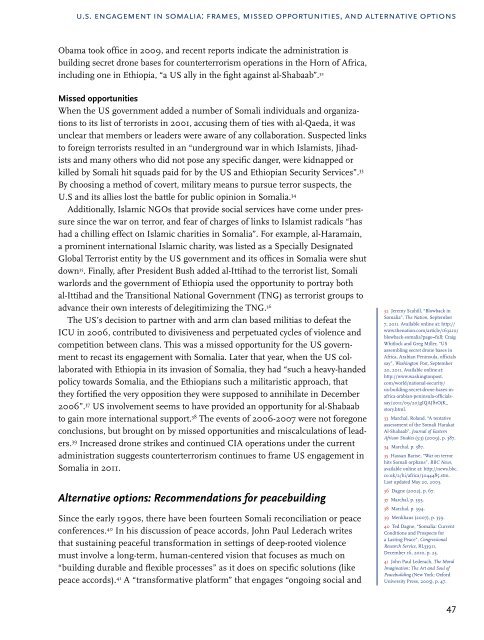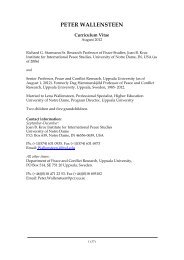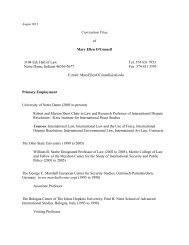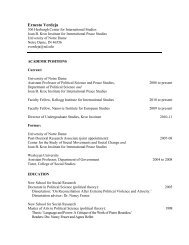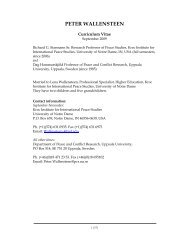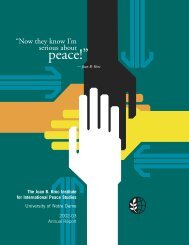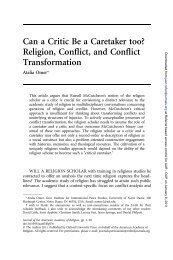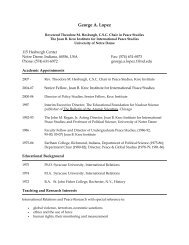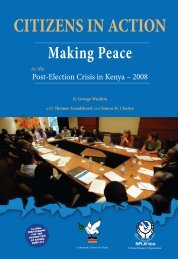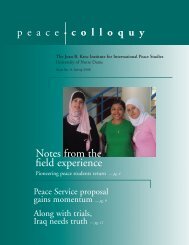Somalia: Creating Space for Fresh Approaches to Peacebuilding
Somalia: Creating Space for Fresh Approaches to Peacebuilding
Somalia: Creating Space for Fresh Approaches to Peacebuilding
You also want an ePaper? Increase the reach of your titles
YUMPU automatically turns print PDFs into web optimized ePapers that Google loves.
u.s. engagement in somalia: frames, missed opportunities, and alternative options<br />
Obama <strong>to</strong>ok office in 2009, and recent reports indicate the administration is<br />
building secret drone bases <strong>for</strong> counterterrorism operations in the Horn of Africa,<br />
including one in Ethiopia, “a US ally in the fight against al-Shabaab”. 32<br />
Missed opportunities<br />
When the US government added a number of Somali individuals and organizations<br />
<strong>to</strong> its list of terrorists in 2001, accusing them of ties with al-Qaeda, it was<br />
unclear that members or leaders were aware of any collaboration. Suspected links<br />
<strong>to</strong> <strong>for</strong>eign terrorists resulted in an “underground war in which Islamists, Jihadists<br />
and many others who did not pose any specific danger, were kidnapped or<br />
killed by Somali hit squads paid <strong>for</strong> by the US and Ethiopian Security Services”. 33<br />
By choosing a method of covert, military means <strong>to</strong> pursue terror suspects, the<br />
U.S and its allies lost the battle <strong>for</strong> public opinion in <strong>Somalia</strong>. 34<br />
Additionally, Islamic NGOs that provide social services have come under pressure<br />
since the war on terror, and fear of charges of links <strong>to</strong> Islamist radicals “has<br />
had a chilling effect on Islamic charities in <strong>Somalia</strong>”. For example, al-Haramain,<br />
a prominent international Islamic charity, was listed as a Specially Designated<br />
Global Terrorist entity by the US government and its offices in <strong>Somalia</strong> were shut<br />
down 35 . Finally, after President Bush added al-Ittihad <strong>to</strong> the terrorist list, Somali<br />
warlords and the government of Ethiopia used the opportunity <strong>to</strong> portray both<br />
al-Ittihad and the Transitional National Government (TNG) as terrorist groups <strong>to</strong><br />
advance their own interests of delegitimizing the TNG. 36<br />
The US’s decision <strong>to</strong> partner with and arm clan based militias <strong>to</strong> defeat the<br />
ICU in 2006, contributed <strong>to</strong> divisiveness and perpetuated cycles of violence and<br />
competition between clans. This was a missed opportunity <strong>for</strong> the US government<br />
<strong>to</strong> recast its engagement with <strong>Somalia</strong>. Later that year, when the US collaborated<br />
with Ethiopia in its invasion of <strong>Somalia</strong>, they had “such a heavy-handed<br />
policy <strong>to</strong>wards <strong>Somalia</strong>, and the Ethiopians such a militaristic approach, that<br />
they <strong>for</strong>tified the very opposition they were supposed <strong>to</strong> annihilate in December<br />
2006”. 37 US involvement seems <strong>to</strong> have provided an opportunity <strong>for</strong> al-Shabaab<br />
<strong>to</strong> gain more international support. 38 The events of 2006-2007 were not <strong>for</strong>egone<br />
conclusions, but brought on by missed opportunities and miscalculations of leaders.<br />
39 Increased drone strikes and continued CIA operations under the current<br />
administration suggests counterterrorism continues <strong>to</strong> frame US engagement in<br />
<strong>Somalia</strong> in 2011.<br />
Alternative options: Recommendations <strong>for</strong> peacebuilding<br />
Since the early 1990s, there have been fourteen Somali reconciliation or peace<br />
conferences. 40 In his discussion of peace accords, John Paul Lederach writes<br />
that sustaining peaceful trans<strong>for</strong>mation in settings of deep-rooted violence<br />
must involve a long-term, human-centered vision that focuses as much on<br />
“building durable and flexible processes” as it does on specific solutions (like<br />
peace accords). 41 A “trans<strong>for</strong>mative plat<strong>for</strong>m” that engages “ongoing social and<br />
32 Jeremy Scahill, “Blowback in<br />
<strong>Somalia</strong>”, The Nation, September<br />
7, 2011. Available online at: http://<br />
www.thenation.com/article/163210/<br />
blowback-somalia?page=full; Craig<br />
Whitlock and Greg Miller, “US<br />
assembling secret drone bases in<br />
Africa, Arabian Peninsula, officials<br />
say”, Washing<strong>to</strong>n Post, September<br />
20, 2011. Available online at:<br />
http://www.washing<strong>to</strong>npost.<br />
com/world/national-security/<br />
us-building-secret-drone-bases-inafrica-arabian-peninsula-officialssay/2011/09/20/gIQAJ8rOjK_<br />
s<strong>to</strong>ry.html.<br />
33 Marchal, Roland. “A tentative<br />
assessment of the Somali Harakat<br />
Al-Shabaab”, Journal of Eastern<br />
African Studies (3:3) (2009), p. 387.<br />
34 Marchal, p. 387.<br />
35 Hassan Barise, “War on terror<br />
hits Somali orphans”, BBC News,<br />
available online at: http://news.bbc.<br />
co.uk/2/hi/africa/3044485.stm.<br />
Last updated May 20, 2003.<br />
36 Dagne (2002), p. 67.<br />
37 Marchal, p. 393.<br />
38 Marchal, p. 394.<br />
39 Menkhaus (2007), p. 359.<br />
40 Ted Dagne, “<strong>Somalia</strong>: Current<br />
Conditions and Prospects <strong>for</strong><br />
a Lasting Peace”, Congressional<br />
Research Service, RL33911,<br />
December 16, 2010, p. 25.<br />
41 John Paul Lederach, The Moral<br />
Imagination: The Art and Soul of<br />
<strong>Peacebuilding</strong> (New York: Ox<strong>for</strong>d<br />
University Press, 2005), p. 47.<br />
47


